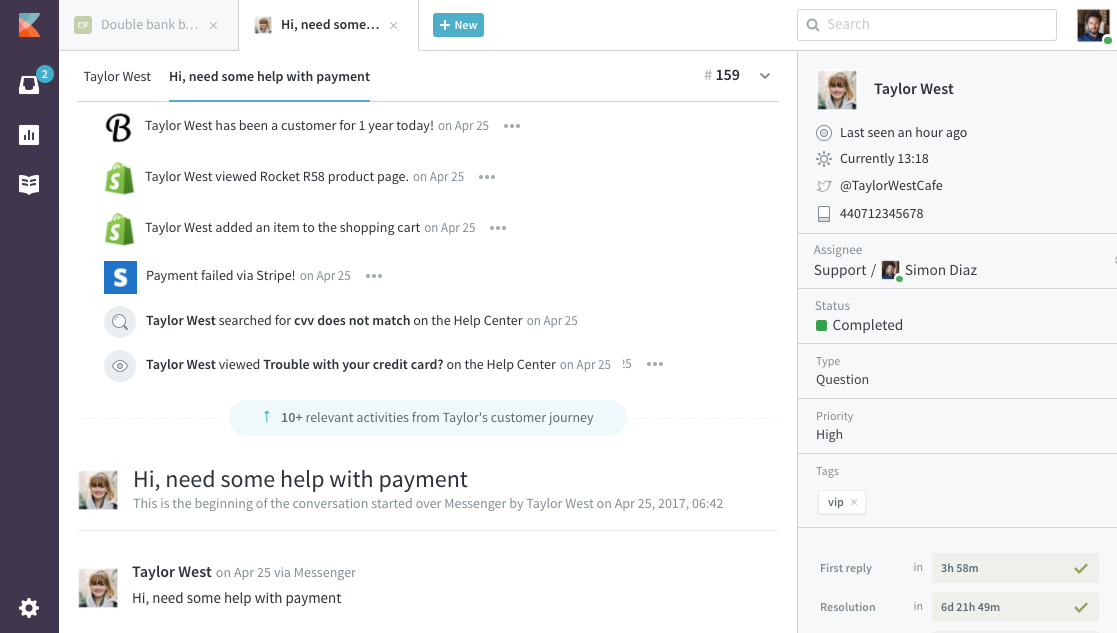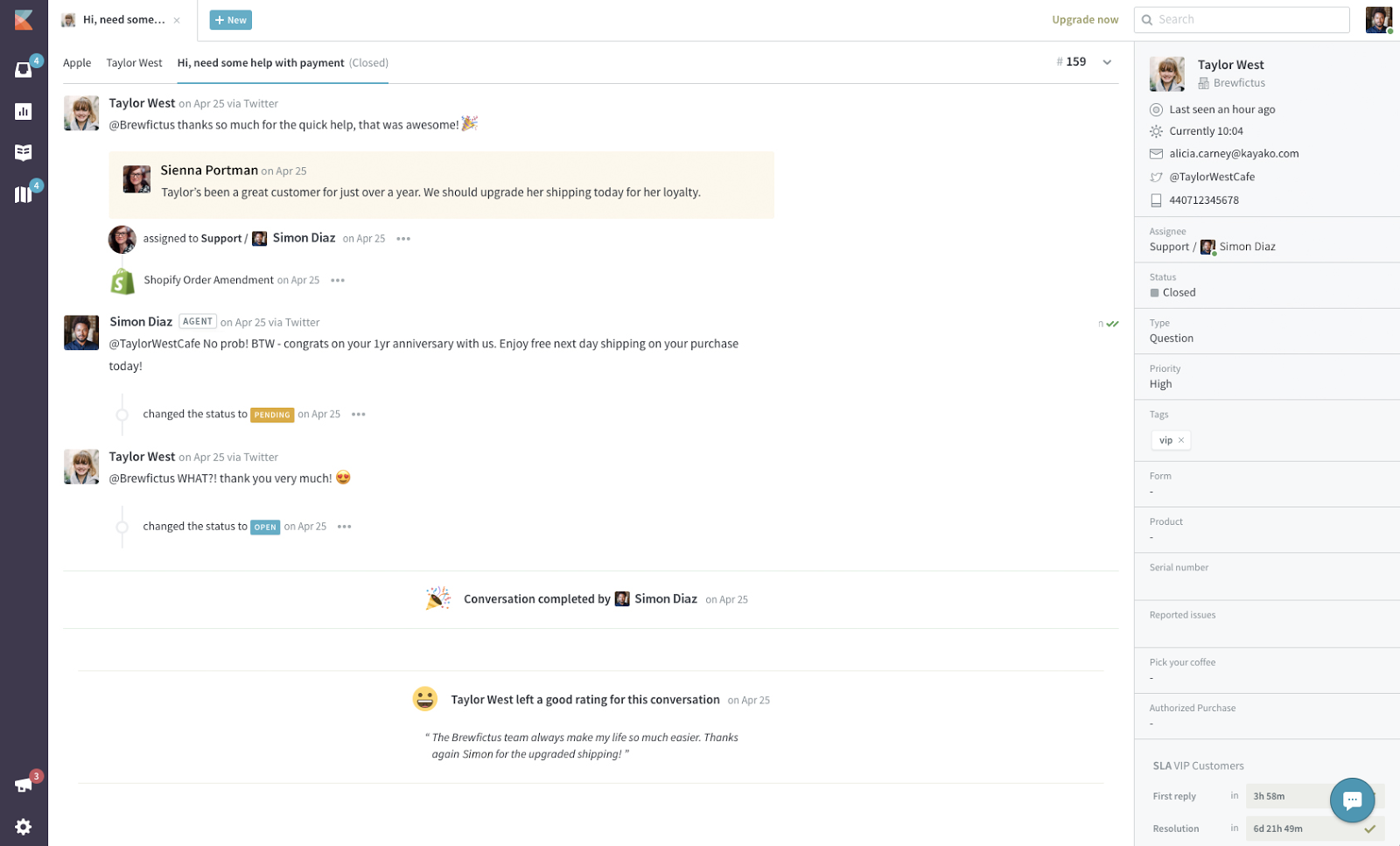Think about your ideal experience as a customer. It felt smooth and quick to get in touch with a sharp and friendly support person, right? You felt heard and understood.
When we experience this type of customer service, excessive effort and endless back-and-forth rarely come to mind.
And yet, we more commonly experience high friction scenarios.
When we’re looking to get help online, we typically check their knowledge base and find some helpful articles that almost solve our issue. But we still need help from their team. So you message them on live chat or maybe send a tweet. All you want is a quick response to solve the problem.
Imagine a world where reply time, a staple of customer support metrics, wasn’t the critical factor — but customer context was?
At this point, you’ve invested your valuable time searching for an answer.
You’ve contacted their support team with your problem. And yet, your first contact experience is spent explaining the steps you’ve already taken, receiving help center articles you’ve already read, and wasting precious time on what you thought was a simple question.
You believe the people at the other end should have that information, and should know you’ve already said this and tried that.
Frustrating, right? We’ve all been there—left wondering what was lost in translation, or how many times you’ll be repeating yourself, and watching your time slip away.
Why is context missing from customer support journeys?
The missing factor that’s critical—and missing from thousands of customer experiences across the globe—is feeling understood.
When you endure frustration like this to get help, it’s no wonder people abandon your business in search of a better customer experience.
And not just a few will leave. CEB found that 96% of customers who exert high effort to resolve their problems become disloyal.
This puts a huge burden on support teams to deliver great customer support experiences; yet incredibly, we rarely know where our customers were before they reached out. We struggle with:
- Reducing back and forth
- Asking the customer less
- Helping our teams see and prepare everything they need
So, it’s become increasingly clear that it’s not speed or even friendliness that influences memorable customer service experiences. Instead, it is context. We are not equipping support teams with the unique context of they need for better customer support journeys.
Visualizing the customer support journey shouldn’t be complicated
Most modern businesses employ a suite of software tools to ensure their business is running smoothly. Ideally, these tools talk with each other to share information about billing, support, marketing efforts, sales, and engineering initiatives.
The information is available, yet customer support teams still struggle to access all of the elements needed to visualize the customer journey in its full context.
It doesn’t have to be this way. The support interaction below is a great example of how customer context can lead to an effortless experience, like the one you imagined earlier.
When support teams know the history of a customer’s journey through your business, the customer needn’t explain their struggle for the umpteenth time or how they ran into the problem. The information is already there.

Creating moments of truth in the customer support journey
If you deliver exceptional customer service, you will be repaid in customer loyalty. We know this to be true in even our own common daily interactions.
When restaurants bring mints or chocolate to your table with your bill, it’s not only because they’re nice people (though surely, they are!). This “unexpected act of kindness” is a tactic. Two studies confirmed its impact on tip percentages received by restaurant servers.
Customers who receive a piece of chocolate with the bill leave a bigger tip than customers who receive no candy, this study reported. Tips vary by how much candy is given and the manner in which the candy is presented to the customer. The study concluded that a theory of reciprocity is the key influencer.
Consumers value a brand with: openness, relevance, empathy, experience, and emotion, according to the customer quotient study. A brand’s performance on these measures predicts loyalty outcomes and is clearly correlated to profit (ROA) and revenue growth.
The results from both of these studies can be directly applied to support conversations to increase customer satisfaction and loyalty.
Here’s another example of how customer journey insights can yield moments of delight and increased customer loyalty.
Context creates moments of delight
Coffee aficionado Taylor West is looking to purchase a coffee roaster called the Rocket R58 by a company called Brewfictus. Brewfictus is the fictional online coffee equipment supplier that Kayako uses to explore customer scenarios and illustrate use cases.
She’s ready to check out, and almost completes the transaction before receiving an error message.
Taylor can’t seem to figure out what’s wrong here. She pokes around the Help Center and eventually contacts the support team.

The Brewfictus support team have all they need to understand the issue Taylor experienced before their first “hello.”
In most customer journeys, this context is missing. But Brewfictus can see her Help Center search history, and what she was looking for before she made contact with them. Stripe and Shopify integrations tell the agent that Taylor’s payment failed due to an incorrect CVV code.
One clean, simple unified customer service journey helped Taylor get exactly what she needed on the first attempt: effortless and personal support.
But, similar to the study of chocolates with the dinner bill boosting tips, by applying the laws of reciprocity, Brewfictus can reward Taylor for her repeat custom with Brewfictus and increase the likelihood of Taylor’s loyalty.
Notice in the customer service journey, the Brewfictus support team can see Taylor’s already been a customer for one year. A second agent pops in and leaves a private note in the journey to suggest an upgrade in Taylor’s Rocket R58 order for next day shipping.

As a customer, this small gesture of kindness goes a long way — both in immediate customer satisfaction metrics (NPS, CSAT) all the way through to lifetime customer value and improved retention rates.
The importance of customer journeys in delivering effective support
With the power of customer journeys on your team’s side, your ideal customer experience becomes a consistent and repeatable way to reduce customer effort, improve satisfaction rates, and delight your customers.
Effortless and memorable customer service doesn’t need to be difficult. Amazing customer service teams can transform into superheroes with just a bit of context.
Do you want the full context of your customer’s support journey? Sign up today for a free trial or personalized demo of Kayako.
